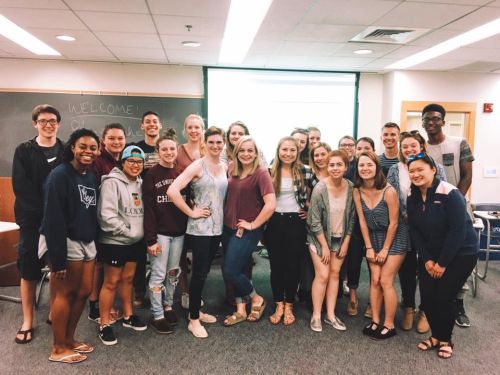According to the American Diabetes Association, approximately 1.25 million American children and adults have type 1 diabetes. For people living with type 1 diabetes, they face the struggle of their bodies not producing insulin. The body breaks down sugars and starches into a simple sugar called glucose, which it uses for energy. Insulin is a hormone that the body needs to get glucose from the bloodstream into the cells of the body. For people with type 1 diabetes, without taking insulin, they would die. For Rachel, Maddie, Sarah and Peter, they live day-to-day checking their blood sugar levels, counting carbs and taking insulin to keep their body functioning. These are their stories.
Rachel’s story

“My life got turned upside down,” Rachel Nawoyski said. “I had to grow up a little faster and take on a lot of responsibility for my health.”
Nawoyski is a typical teenage girl from New Jersey who is very involved at her high school between clubs and sports. Typically people can not tell she is living with a disease but she is and will be for the rest of her life. Nawoyski was diagnosed with type 1 diabetes at just seven- years-old.
Nawoyski wears an insulin pump that she hides under her clothing at all times to regulate her blood sugar.
“The pump is a device, not that big, that delivers my insulin through a thin tubing and a needle that’s in me,” Nawoyski said. “I change that needle every 3-4 days and refill the cartridge of insulin when needed.”
“There are times when it gets extremely exhausting and you just don’t want to deal with it anymore,” Nawoyski said. “Diabetes takes a lot of responsibility and effort to manage.”
Having type 1 diabetes, although it gets tiring at times, never really stops Nawoyski from reaching her goals. She never lets her diabetes define her as a person. Next year, she plans on attending Rowan College at Gloucester County where she will begin working towards obtaining a bachelor’s degree in early childhood education.
“It’s not that bad balancing school work and extracurricular activities while having diabetes,” Nawoyski said. “I get good grades and I am involved in clubs and sports and I even have a job. Diabetes never really slows me down with that stuff, as long as I manage myself before hand, I’m okay.”
Nawoyski does her best with managing her diabetes and does not let it stop her but she wants the world to know that it is not always easy.
“I really hope a cure comes soon because it is a tough disease to have especially when you’re young and your childhood gets cut off a little,” Nawoyski said. “People with good health should really appreciate it because no one should ever have to have this disease or any disease in general.”
Maddie’s Story

“Being a college athlete has been the best thing for my type 1 diabetes,” Maddie Maloney said.
Maddie Maloney, a division I tennis player at Seattle University, majoring in marketing and minoring in nonprofit leadership was diagnosed with type 1 diabetes just two months after her thirteenth birthday as a seventh grader.
“I was quiet about my diabetes when first diagnosed and did not want people to know,” Maloney said in an email. “I was very responsible with it though. My parents have never checked my sugar or administered insulin.”
Like most college students with type 1 diabetes, it took Maloney time to adjust to college life with diabetes. Remembering to eat on time, manage stress and check blood sugar levels does not come easy while balancing a full course load and being a division I athlete.
“Being a college athlete has been the best thing for my type 1 diabetes,” Maloney said. “The reason I say this, is because I have a very strict schedule I follow daily with workouts, class, and tennis practice. This makes it easy to get in a routine and helps my diabetes.”
Maloney notes that working out is a great way to keep blood sugar levels under control and being an athlete has given her a great support system: close teammates she can always count on.

“I feel safe here because everyone knows I have diabetes and how to help me if I ever need it,” Maloney said.
Drinking in college can be tough for people with diabetes. According to the American Diabetes Association, alcohol can cause hypoglycemia shortly after drinking and for up to 24 hours after drinking therefore it is not always the best idea for diabetics to consume alcohol. Maloney tends to avoid partying to keep her health in good standing and to make sure she is always representing her university well.
“Being an athlete means you are held to a higher standard because you are always representing the university so I do not party much which is also something diabetics struggle with,” Maloney said.
Maloney wishes to see a cure within her lifetime, but she also lives in the now and does what she can to be the very best version of herself while living with this disease.
“I live a very full life as a type 1 diabetic,” Maloney said. “Being a diabetic has made me strong, healthy, and understanding and I am beyond thankful for that. I believe there is a cure in the near future, but until then it is my job to help all the other type 1 diabetics live their lives as fully as possible.”
Peter’s story

“I don’t want to say it controls your life, but it controls your life,” Peter Wolf said.
Wolf was diagnosed with type 1 diabetes at age 18, he is now 49-years-old and a father of two.
“That day I remember it very clearly,” he said. “I woke up on a Sunday morning, I went out to wash my car down the corner from my house where my grandmother lived and I knew the signs because my father had it [diabetes]. I knew something was wrong.”
Wolf’s mother took him to the hospital to get his blood sugar levels checked.
“The doctor came into the room and said 684, you got it.”
Wolf took the news quite well and spent the next day learning how check his own blood sugar and give himself a shot. “I already knew what I had to do,” Wolf said.
“I was not really upset about it at first after a couple of months, but I had some rebellious points in my life where I was upset that I had it, angry that I had it,” Wolf said. “It really means nothing at this point though because I have it, there is nothing I can do about it.”
Wolf has learned to live a normal life despite living with an incurable disease.
“The insulin lasts in your body for about three hours so after three hours it’s gone,” Wolf said. “The more you check and adjust, the better chance you have at a normal life.”
“I literally check my blood sugar about ten times a day, so no matter what is going on I have to stop and check it,” Wolf said. “On a normal day I take six shots but there are plenty of days that I might take eight or nine insulin shots in a day.”
Wolf has developed what is called hypoglycemic unawareness. His blood sugar can be low and he does not know that it is low which could ultimately leave him in diabetic shock.

“People around me, if they don’t know that my blood sugar is low they don’t know what’s going on with me,” Wolf said. “Fortunately, people that know that I’m a diabetic and have experienced the situation with me, they can do something about it because I basically can’t do anything.”
Living with diabetes is not only a physical difficulty. It is also a financial struggle for many. Luckily, Wolf has health insurance but his medical bills are still quite high. According to a study conducted by the American Diabetes Association, people with diagnosed diabetes, on average, have medical expenditures approximately 2.3 times higher than what expenditures would be in the absence of diabetes.
“First of all, if I didn’t have health insurance I would not be able to survive,” Wolf said. “You’re looking at a cost of approximately $1,500 a month to stay alive.”
Wolf puts out about $150 a month after health insurance to cover the costs of his two types of insulin he takes and his test strips.
“Basically you’re looking at more than a mortgage payment just to stay alive, it’s not like this is an option…if I don’t have this I’m dead,” Wolf said.
If Wolf did not have health insurance, “I could not survive, I really could not survive. And I pay a lot of money for my health insurance, about $10,000 a year for me and the kids, it is a lot of money,” Wolf said.
Sarah’s story

“It’s hard, it’s not easy but it’s also not easy for anybody,” she said. “College is hard. Having a chronic illness doesn’t make it any easier, but it is manageable. I deal with it. I do the best I can.”
Sarah Raschbaum is a freshman at Loyola University in Maryland who is studying sociology. She is living away from her home in New Jersey in a college dorm room where she often wakes up in the middle of the night checking to make sure her blood sugar levels are stable.
Raschbaum was diagnosed with type 1 diabetes at just the age of four-years-old. A time when her parents had to take care of her health for her.
“I mean when I was little it’s not that I didn’t understand what it was, but it wasn’t as big of a deal to me because my parents took care of it for me,” Raschbaum said. “It was hard but it didn’t really hit me how hard it really is until I was independent with it which was around age 11 or 12.”
Once Raschbaum was responsible for her own diabetes she wound up attending a summer camp in Pennsylvania for type 1 diabetics.
“That [the camp] helped me a lot,” Raschbaum said. “It provided me with a really strong support system. I started going when I was 12 and I still go as a counselor now.”
“I have always had a pretty good relationship with my diabetes,” Raschbaum said. “There were times in high school when I had burnouts for sure, where I just struggled a lot with it.
But Raschbaum never let the bad days keep her down. After high school, Raschbaum was really excited for a new chapter in her life: college.
“I was so excited to go to college and I kind of just assumed we had some kind of diabetes support group on campus but when I got here there was literally nothing,” Raschbaum said. “As an 18 year old, first semester student, it was really really hard and I didn’t know anyone else with type 1 here.”
First semester at college is hard for most, it was even harder for Raschbaum.
“It was really hard in the beginning it was a huge adjustment… I wasn’t sleeping the same way that i was at home,” Raschbaum said. “My blood sugar was going low like four or five times every night. I was up so much at night it was ruining my days. It was not a good situation. I would call home just crying to my parents saying ‘I can’t do this, it’s just too much.’”
Even typical day-to-day experiences like eating in the cafeteria or getting a full night’s rest are more difficult for Raschbaum than the average college freshman.
“My ability to get to classes I think is harder, this school [Loyolya University] is only 5000 undergrad, classes are much smaller so it is not like if you skip a class your professors won’t know,” Raschbaum said. “For the most part you are expected to go to all your classes.”
“There are times when I am up all night taking care and treating my blood sugars I just can not get up in the morning… It is really hard to explain that to professors,” Raschbaum said. “They are understanding, but people can only be so understanding when they don’t really understand what diabetes is.”
Raschbaum continues to push through the tough times and has made it almost all the way though her first year at Loyola but after one semester of struggling Raschbaum realized she needed to do something. She wanted to create a support system on campus for students like herself so that is what she did. She took initiative and started a club on her campus for students with diabetes.

The club is a chapter of the already established College Diabetes Network (CDN), which is a non-profit organization whose mission is to provide innovative peer based programs which connect and empower students and young professionals to thrive with diabetes.
The College Diabetes Network is rapidly growing as college students like Raschbaum across the US are starting CDN chapters at their college campuses.
“I think awareness and advocacy is something that needs to be more prevalent on college campuses and that is something we are definitely going to be dong as a group,” Raschbaum said.
Raschbaum is serving as the president of the club and her friend Cate Cummings, the vice president, who Raschbaum introduced herself to one day when she noticed Cummings wearing an insulin pump on her arm.
“I asked Kate if she wanted to start the club with me,” Raschbaum said.” “Kate said ‘yeah I don’t know anything about it but we can figure it out.’”
Raschbaum held the first CDN meeting a few weeks ago and had a great turn out.
“About 25 to 30 people were at the first meeting which was really cool, it was so much better than we expected, Raschbaum said.
Raschbaum hopes to hold various events on Loyola’s campus to bring awareness to others about type 1 diabetes. At the meeting ideas were brainstormed for events including a possible campus walk, awareness weeks with posters hung around campus and a day for local kids with type one to visit campus and meet the school’s mascot.
After the first meeting, Raschbaum is very optimistic and excited for what is to come next.
“Already, I walk down the street and see more familiar faces and more people who i can connect with,” Raschbaum said.
When asked how she hopes the CDN chapter at her school will make a difference in her college career she said, “it’s [the club] less about my college career are more about the other people that it affects. I just hope that by starting this it helps other people that might be struggling with type 1 or have some kind of connection and might be struggling.”
Her final thought, “it’s not easy, just because it is a silent disease that doesn’t make it easy, but it is also not the be all end all,” Raschbaum said. “You can live with it… you can go to college, have a career and live your life… you should feel just as empowered as someone without diabetes.”



